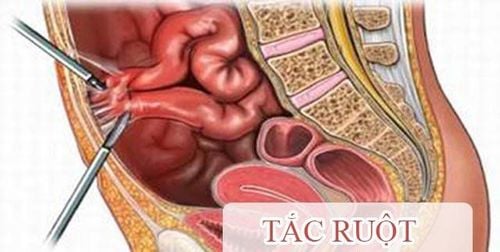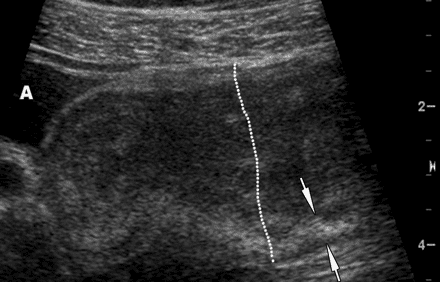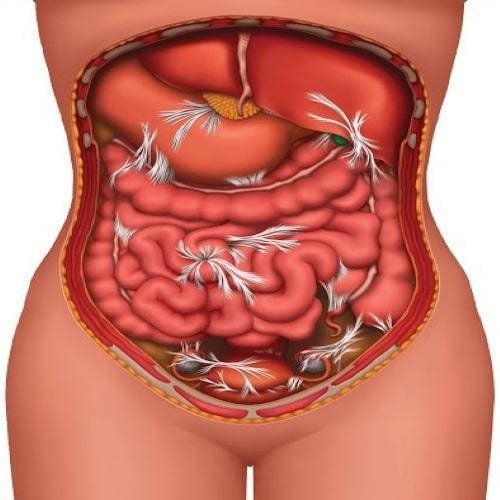This is an automatically translated article.
The article is professionally consulted by MSc, BS. Dang Manh Cuong - Doctor of Radiology - Department of Diagnostic Imaging - Vinmec Central Park International General Hospital. The doctor has over 18 years of experience in the field of ultrasound - diagnostic imaging.Intestinal obstruction is a common surgical emergency only after appendicitis. The causes of intestinal obstruction are diverse, the signs and symptoms of intestinal obstruction also vary depending on the cause and location of the bowel obstruction. Therefore, the diagnosis of intestinal obstruction relies heavily on imaging tests, including ultrasound. So what role does gastrointestinal ultrasound play in the detection and differential diagnosis of intestinal obstruction?
1. What is an intestinal obstruction?
Intestinal obstruction is a disease that occurs when the circulation of gas, digestive juices and food in the intestinal lumen is blocked for various reasons. Intestinal obstruction has two basic clinical forms: functional intestinal obstruction and mechanical intestinal obstruction:Mechanical intestinal obstruction: Occurs due to mechanical obstructions at locations from the angle of Treitz to the anal canal. Functional bowel obstruction: Occurs due to cessation or loss of bowel movements, also known as paralytic ileus. Intestinal obstruction is a common surgical emergency following appendicitis. The disease accounts for about 9-19% in abdominal-related emergencies and 0.8-1.2% in general surgical diseases.
The disease can be fatal with a rate of about 3-5%. However, thanks to advances in medicine, especially the development of surgical specialties, the mortality rate is decreasing.

2. Identify the causes of intestinal obstruction from the ultrasound results of the gastrointestinal tract
The causes of intestinal obstruction are very diverse, the exact diagnosis of the cause depends heavily on the laboratory tests. Among the tests, gastrointestinal ultrasound plays an important role in supporting diagnosis and treatment.2.1. Causes of small bowel obstruction
Causes that can be detected by ultrasound in the diagnosis of intestinal obstructionHernia strangulation ; Intussusception; Paralytic ileus due to gallstones; Primary or secondary tumor, intraluminal or extraluminal; Chronic enteritis: Crohn's disease, tuberculous enteritis (relatively rare). Causes that are difficult to detect when using ultrasound to diagnose intestinal obstruction :
Postoperative intestinal adhesions ; Narrow junction; Food residues; Bowel volvulus; Internal hernia; Anemia, intestinal necrosis.

2.2. Causes of intestinal obstruction in the colon
In principle, the following causes of large bowel obstruction can be detected on ultrasound:Primary or secondary tumor; Chronic colitis such as Crohn's disease, hemorrhagic colitis, tuberculosis enteritis. In addition, the causes are difficult to detect on ultrasound to diagnose large bowel obstruction:
Post-inflammatory bowel obstruction such as: diverticulitis causing intestinal obstruction, acute pancreatitis causing intestinal obstruction (rare); Bowel volvulus; Scarring surgery after bowel surgery.
3. The role of ultrasound in the diagnosis of intestinal obstruction
Gastrointestinal ultrasonography in the diagnosis of intestinal obstruction shows characteristic images. In addition, ultrasound diagnosis of intestinal obstruction can also determine the location and cause.If in the early stage, when the bowel loops are not dilated, ultrasound detects diseases such as intussusception, tumor, abscesses... and combined with clinical symptoms can diagnose intestinal obstruction stage. Soon.
Features that can be detected when using ultrasound to diagnose intestinal obstruction:
Image of dilated bowel loops; Peristalsis increases in the early stages and completely disappears in the later stages; Abnormal fluid in the abdominal cavity If mechanical intestinal obstruction, ultrasound of the gastrointestinal tract can record the following signs:
The diameter of the intestinal lumen is increased. In a normal person, the diameter of the small intestine is about 3cm, that of the colon is about 5cm; The normal intestinal wall thickness is about 3mm-5mm. In the early stages of intestinal obstruction, this thickness is reduced to less than 3mm, in the late stage, this thickness increases by more than 5mm due to inflammation and edema; Ultrasound detects that the intestinal lumen contains a lot of fluid, gas and sound-sound substances; Intestinal peristalsis increases from time to time in the obstructed bowel, especially the fluid in the intestinal lumen moving forward, backward and vortex is a sign to distinguish intestinal obstruction from paralytic ileus; Complete loss of bowel motility in one segment while increasing motility in others (this is also a distinguishing sign from paralytic ileus); The amount of fluid in the abdomen increases rapidly with multiple consecutive ultrasounds;

However, in general, gastrointestinal ultrasound has a limited role in the disease. bowel obstruction. There are many reasons that affect the results of ultrasound to diagnose intestinal obstruction such as: abdominal distention, the results depend on the subjectivity of the reader...
4. Evolution of bowel obstruction
The progression of intestinal obstruction can go through 4 steps:Initiation phase: The patient has severe abdominal pain, vomiting, severe cases may appear shock. Signs of local intestinal obstruction are variable and reversible throughout the body. At this stage, ultrasound of the gastrointestinal tract is difficult to detect intestinal obstruction; Stage 2: Periodic abdominal pain with abdominal distension at the site of obstruction, the examination may hear a yawning sound. Ultrasound at this stage can show increased peristalsis in the lesion site. At this stage the bowel obstruction is reversible and reversible; Stage 3: The characteristics of this stage are reduced bowel movements, generalized abdominal distension, dull abdominal pain, no attacks. Accompanying systemic signs such as toxic infection. This is probably the most common ultrasound stage to detect bowel obstruction. At this time, the disease cannot heal on its own but requires surgical treatment; The final stage: Abdominal examination no longer feels the abdominal wall, the abdomen is distended, vomiting a lot. Other signs indicate a serious condition such as dehydration, infection, severe intoxication, and the patient can die if left untreated.

Vinmec International General Hospital has applied ultrasound technology in examination and diagnosis of many diseases. Accordingly, the ultrasound technique at Vinmec is carried out methodically and according to the standards of the process by a team of highly skilled doctors and nurses, modern machinery system, thus giving accurate results, making a significant contribution to the quality of life. in determining the disease and stage of intestinal obstruction for timely treatment.
Please dial HOTLINE for more information or register for an appointment HERE. Download MyVinmec app to make appointments faster and to manage your bookings easily.














